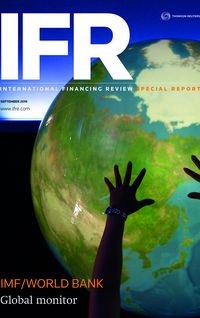The Middle East has been one of the busiest regions in emerging market bonds this year, but non-financial corporate issuers largely remain a no-show in a market resistant to increasing corporate transparency.
Borrowers in the Gulf have printed US$33.25bn of deals since January 1, according to IFR data, and market watchers say there is plenty of juice left for the year.
“There’s more to come,” said Abrar Hussain, head of DCM for the Middle East at Credit Agricole. “Sovereigns will need to keep borrowing money to fund their budget deficits and to build out a sovereign yield curve – taking it from the local market is cannibalising liquidity available for the domestic private sector.”
The big one on the horizon is Saudi Arabia’s highly anticipated bond market outing due in September, with around US$15bn expected to be placed in a deal that is expected to be the first of many from the sovereign.
“Saudi has the critical size to become a regular issuer,” said one Middle East analyst. “It looks like they are really considering [the incoming deal] from a longer term view.”
This will likely mean that investors can expect a fairly chunky premium as the A1/A–/AA– rated issuer looks to make friends among the bond-buying community.
“Saudi will pay the right price to ensure their transaction is a success, building a strong relationship with investors and leaving the door wide open for future issuance, just as others from the region have,” said Hussain. “This may mean being generous in terms of pricing.”
The most obvious comparable is Qatar’s triple-tranche US$9bn deal that printed in May. While Double B rated Qatar is higher rated than its much larger neighbour, there have been few other recent trades from the Gulf that are anywhere near the size Saudi wants.
The US$3.5bn 10-year part of Qatar’s deal was trading at a Z-spread of 152bp at the end of August, according to Tradeweb, after printing at 150bp over Treasuries.
Sovereigns line up
It is not just Saudi eyeing bonds. Bahrain and Kuwait have long been rumoured to be considering debt – most likely waiting for Saudi to come before taking the plunge.
“Large fiscal deficits have triggered increased external borrowing from GCC countries,” said Steffen Dyck, an analyst at Moody’s. “In some cases … domestic liquidity has tightened, so external issuance helps to alleviate pressures on that end.”
But even repeated returns to the bond market will not make much of a dent on Gulf sovereigns’ debt to GDP ratios.
“The debt-to-GDP is low compared to other emerging market countries,” said Hussain at Credit Agricole. “So, even if Gulf sovereigns do start borrowing every year, there is significant headroom to continue to borrow before this particular credit metric is impacted.”
Saudi’s debt-to-GDP ratio was just 5.8% in 2015, according to Thomson Reuters. By comparison, A2/A–/A– rated Poland’s was 53.18%.
As well as good debt metrics, there has been some respite for Gulf sovereigns from the worst of their oil price-related money worries. Brent crude has found a floor around the mid-US$40 a barrel range and has not traded below US$40 since April.
Although a far cry from the more thank US$100-per-barrel highs last seen in 2014, this has still been game-changing for some of the region’s economies. Kuwait, for example, relies on hydrocarbons for around 90% of its revenues, and will generate an extra 6%–7% of GDP over 2016 and 2017 because oil has moved off of its sub-US$30 lows seen at the beginning of this year, according to Moody’s.
This will bring Kuwait’s fiscal deficit down to 3% of GDP in 2016 and almost 0% next year. Moody’s previously had the fiscal deficit forecast at 9.9% and 6.4%, respectively.
Where sovereigns lead…
Following the sovereigns into the market have been the region’s banks, which were pumping out deals because of the dual deadlines of Eid on September 13 and the likelihood that Saudi Arabia will take investors’ full attention when it finally hits screens.
Emirates Islamic Bank printed a US$250m tap at the end of August of its US$750m 3.542% sukuk due May 2021, with an order book above US$700m, including interest from the joint lead managers. And Sharjah Islamic Bank printed a US$500m five-year sukuk issue at the beginning of September.
“It’s going to be a busy time for banks trying to print before the Saudi deal,” said one bond banker from the region.
And it is not just the regular issuers that are being drawn to the market. Qatar National Bank brought its first US dollar trade in three years to print a US$1bn five-year bond a few basis points above fair value.
“The markets are strong, oil is stable and there’s a big deal expected,” said one syndicate banker. “Why would you not come if you can?”
…not everyone follows
But there has been a noticeable gap in the types of borrower tapping the market. Sovereigns make up the chunky trades, while financial institutions plug into the demand for five-year paper, but corporate issuers are few and far between.
“A certain lack of transparency is still an issue,” said Dyck at Moody’s. “Especially for investors outside the region.”
Dubai’s Emaar Properties (Baa3/BBB–) is one of the few corporate issuers from the region to try its luck. The issuer made its first US dollar outing in four years with a US$750m 10-year Reg S sukuk transaction on September 7.
And there was plenty of demand for the trade, with 90, mostly Middle Eastern, investors pumping the book up to around US$2.3bn.
But other than that deal, the corporate pipeline looks sparse for the region.
And it has not been particularly busy throughout the year. Benchmark trades from Majid Al Futtaim, Taqa and Ooredoo over the summer and a handful for the rest of the year are all investors have had to consider. This looks unlikely to change, despite sovereigns creating pricing benchmarks by building their own bond curves.
“I don’t think the sovereigns coming will open the floodgates to corporate issuance,” said Hussain at Credit Agricole. “There will be some increase for sure, as local bank liquidity is not as readily available as it was in the past.”
Like Dyck at Moody’s, Hussain says that transparency is the issue: “Lots of corporates are not quite there in terms of the level of disclosure required to access the capital markets.”
Instead, companies from the Gulf have been content with turning to the local bank market, though bank liquidity has dried up some with the reduced oil price.
International bank loans are another popular choice over bonds, as they do not require the same level of public disclosure. Aluminium Bahrain is the latest Gulf name to turn to international banks, the borrower first went to banks seeking a US$750m seven-year loan to finance an aluminium smelter complex, Reuters reported. This has since been increased to US$1.5bn.
The credit is looking to raise US$3bn in total, though said it will rely on commercial bank loans and export credit agencies for funding before it considers an international bond (see Loans story for more).
But although there is a dearth in new corporate issuers coming out of the woodwork in the Gulf, the market is expected to adapt, with issuers that have only printed in Reg S format potentially starting to look at adding 144A documentation to their bonds – opening up the onshore US investor base to their deals.
Already, some issuers have embraced the change, with Taqa and Oredoo printing Reg S/144A deals in June.
And the effort paid off. Oredoo priced its US$500m 10-year bond 5bp inside its own curve and the allocation statistics saw US investors pick up just shy of 20% of the trade.
The sukuk market appears to be particularly ripe for this, as almost all sharia-compliant bonds are issued in Reg S format.
This year, only two issuers – Malaysia and Indonesia – have printed sukuk in 144A/Reg S format, according to IFR data.
“In this day and age, it might make more sense to look at 144A because there is relatively less cash in the [Middle East] and it gives a wider access to lots more investors,” said Sachin Davé, a partner at Allen & Overy.
But shifting from Reg S-only to 144A in sukuk comes with its own set of problems. The first is cultural – sukuk issuers have always been able to get all they need and more from the Reg S market, so many will be loath to take the time and cost-hits to get a deal ready for US onshore investors.
The second factor stopping the move is trickier to navigate.
“Sukuk can trip up Volker rule problems relating to ownership of the asset, which can result in additional capital charges for banks,” said Davé. “It adds another layer of analysis, but it is not insurmountable.”
The interaction between sukuk and the Volker rule is complex and intricate, according to Davé, but it is a result of unintended consequences of the Volker rule’s treatment of speculative assets rather than a specific set of rules barring Islamic finance.
But for these reasons, only the biggest issuers from the region are expected to lead the way in making the leap from Reg S to 144A.
“The first place we will see it is in sovereign issuance, because it’s just not that different in disclosure requirements for Reg S and 144A,” said Davé.
To see the digital version of this special report, please click here
To purchase printed copies or a PDF of this report, please email gloria.balbastro@tr.com



